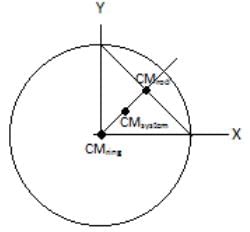Class 11 Exam > Class 11 Questions > An object comprises of a uniform ring of radi...
Start Learning for Free
An object comprises of a uniform ring of radius R and its uniform chord AB (not necessarily made of the same material) as shown. Which of the following can not be the centre of mass of the object.
- a)(R/3, R/3)
- b)(R/3, R/2)
- c)(R/4, R/4)
- d)None of these
Correct answer is option 'B'. Can you explain this answer?
Verified Answer
An object comprises of a uniform ring of radius R and its uniform chor...

Since the points must have symmetric coordinates so B is the answer.
Most Upvoted Answer
An object comprises of a uniform ring of radius R and its uniform chor...

Since the points must have symmetric coordinates so B is the answer.
Free Test
FREE
| Start Free Test |
Community Answer
An object comprises of a uniform ring of radius R and its uniform chor...
B) (R3, R/2)

|
Explore Courses for Class 11 exam
|

|
Question Description
An object comprises of a uniform ring of radius R and its uniform chord AB (not necessarily made of the same material) as shown. Which of the following can not be the centre of mass of the object. a)(R/3, R/3)b)(R/3, R/2)c)(R/4, R/4)d)None of theseCorrect answer is option 'B'. Can you explain this answer? for Class 11 2025 is part of Class 11 preparation. The Question and answers have been prepared according to the Class 11 exam syllabus. Information about An object comprises of a uniform ring of radius R and its uniform chord AB (not necessarily made of the same material) as shown. Which of the following can not be the centre of mass of the object. a)(R/3, R/3)b)(R/3, R/2)c)(R/4, R/4)d)None of theseCorrect answer is option 'B'. Can you explain this answer? covers all topics & solutions for Class 11 2025 Exam. Find important definitions, questions, meanings, examples, exercises and tests below for An object comprises of a uniform ring of radius R and its uniform chord AB (not necessarily made of the same material) as shown. Which of the following can not be the centre of mass of the object. a)(R/3, R/3)b)(R/3, R/2)c)(R/4, R/4)d)None of theseCorrect answer is option 'B'. Can you explain this answer?.
An object comprises of a uniform ring of radius R and its uniform chord AB (not necessarily made of the same material) as shown. Which of the following can not be the centre of mass of the object. a)(R/3, R/3)b)(R/3, R/2)c)(R/4, R/4)d)None of theseCorrect answer is option 'B'. Can you explain this answer? for Class 11 2025 is part of Class 11 preparation. The Question and answers have been prepared according to the Class 11 exam syllabus. Information about An object comprises of a uniform ring of radius R and its uniform chord AB (not necessarily made of the same material) as shown. Which of the following can not be the centre of mass of the object. a)(R/3, R/3)b)(R/3, R/2)c)(R/4, R/4)d)None of theseCorrect answer is option 'B'. Can you explain this answer? covers all topics & solutions for Class 11 2025 Exam. Find important definitions, questions, meanings, examples, exercises and tests below for An object comprises of a uniform ring of radius R and its uniform chord AB (not necessarily made of the same material) as shown. Which of the following can not be the centre of mass of the object. a)(R/3, R/3)b)(R/3, R/2)c)(R/4, R/4)d)None of theseCorrect answer is option 'B'. Can you explain this answer?.
Solutions for An object comprises of a uniform ring of radius R and its uniform chord AB (not necessarily made of the same material) as shown. Which of the following can not be the centre of mass of the object. a)(R/3, R/3)b)(R/3, R/2)c)(R/4, R/4)d)None of theseCorrect answer is option 'B'. Can you explain this answer? in English & in Hindi are available as part of our courses for Class 11.
Download more important topics, notes, lectures and mock test series for Class 11 Exam by signing up for free.
Here you can find the meaning of An object comprises of a uniform ring of radius R and its uniform chord AB (not necessarily made of the same material) as shown. Which of the following can not be the centre of mass of the object. a)(R/3, R/3)b)(R/3, R/2)c)(R/4, R/4)d)None of theseCorrect answer is option 'B'. Can you explain this answer? defined & explained in the simplest way possible. Besides giving the explanation of
An object comprises of a uniform ring of radius R and its uniform chord AB (not necessarily made of the same material) as shown. Which of the following can not be the centre of mass of the object. a)(R/3, R/3)b)(R/3, R/2)c)(R/4, R/4)d)None of theseCorrect answer is option 'B'. Can you explain this answer?, a detailed solution for An object comprises of a uniform ring of radius R and its uniform chord AB (not necessarily made of the same material) as shown. Which of the following can not be the centre of mass of the object. a)(R/3, R/3)b)(R/3, R/2)c)(R/4, R/4)d)None of theseCorrect answer is option 'B'. Can you explain this answer? has been provided alongside types of An object comprises of a uniform ring of radius R and its uniform chord AB (not necessarily made of the same material) as shown. Which of the following can not be the centre of mass of the object. a)(R/3, R/3)b)(R/3, R/2)c)(R/4, R/4)d)None of theseCorrect answer is option 'B'. Can you explain this answer? theory, EduRev gives you an
ample number of questions to practice An object comprises of a uniform ring of radius R and its uniform chord AB (not necessarily made of the same material) as shown. Which of the following can not be the centre of mass of the object. a)(R/3, R/3)b)(R/3, R/2)c)(R/4, R/4)d)None of theseCorrect answer is option 'B'. Can you explain this answer? tests, examples and also practice Class 11 tests.

|
Explore Courses for Class 11 exam
|

|
Signup for Free!
Signup to see your scores go up within 7 days! Learn & Practice with 1000+ FREE Notes, Videos & Tests.


















